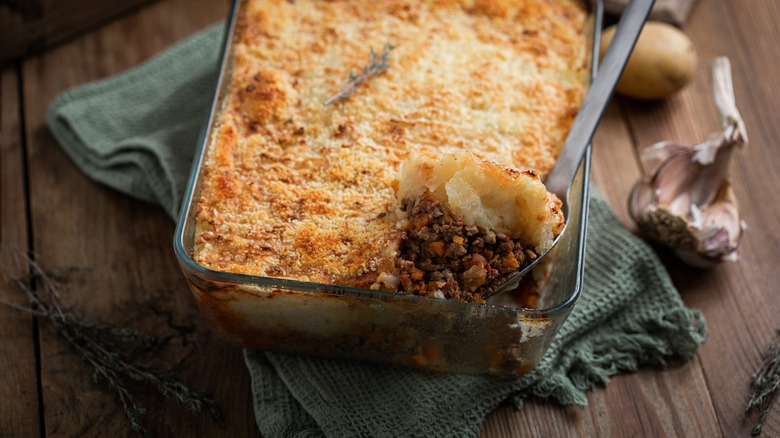What Is Cumberland Pie, And How Is It Different From Shepherd's Pie?
Cumberland pie is a classic U.K. dish, but despite its confectionery title, this "pie" isn't a dessert. At first glance, Cumberland pie appears the same as another British dish shepherd's pie — and very similar to cottage pie, which is both English and Irish. With that said, there are distinct differences that make all three of these hearty comfort classics unique.
Like shepherd's pie, Cumberland pie is a layered, roasted, casserole-style dish consisting of stewed meat topped by a layer of mashed potatoes. But, where shepherd's pie is made with ground lamb (hence the "shepherd" name), and cottage pie is made with beef mince, Cumberland pie can be made with lamb, beef, or a combination of both. Specifically, the Cumberland version should be made with larger, toothy chunks of browned meat, not mince. A rare preparation might use minced beef and chunked lamb for textural intrigue. Other modern versions even use Cumberland sausage, a regional English pork sausage flavored with mace, sage, and pepper.
Beneath the mashed potato layer, that meat gets mixed with a tender, aromatic vegetable medley of onion, leek, carrot, celery, thyme, and bay leaves cooked in savory Worcestershire sauce and acidic tomato puree. To finish, Cumberland pie is topped with a garnishing layer of melted, grated cheddar or Lincolnshire cheese along with golden toasted breadcrumbs. The cheese can also be stirred into the potatoes rather than sprinkled on top with the breadcrumbs.
Cumberland pie uses beef and/or lamb chunks, while shepherd's pie uses just ground lamb
Cumberland pie is named after its region of origin, a county located on the far coastal edge of northwestern England. Cumberland is bordered by Scotland, the Solway Firth, the Irish Sea, and fellow historical regions Durham, Lancashire, Northumberland, and Westmorland. The eponymous dish can be traced back to medieval Britain, during which time Cumberland pie was made with any combination of available proteins from assorted game meat to Herdwick mutton. The veggies in the dish are emblematic of Cumbria's enduring agricultural heritage. These early pies actually used a pastry pie crust instead of mashed potatoes, and also included sweet elements with dried fruit, apples, and baking spices.
Today, Cumberland pie remains an especially beloved, niche regional dish in the Lake District and Cumbria (which is also the birthplace of sticky toffee pudding). Beyond the protein element, the spuds are also subject to some variation. Older versions of the pie swap the mashed potatoes for a layer of thinly-sliced potato rounds arranged across the top of the dish, but this presentation is less common. More often, the potatoes are passed through a ricer for maximum creaminess. Traditional preparations might also include a gravy made from beef stock, redcurrant jelly, and cider. We like to enjoy our shepherd's pie with a glass of merlot or a deep red cab, which would also pair extraordinarily well with starchy, meaty, cheesy Cumberland pie.

